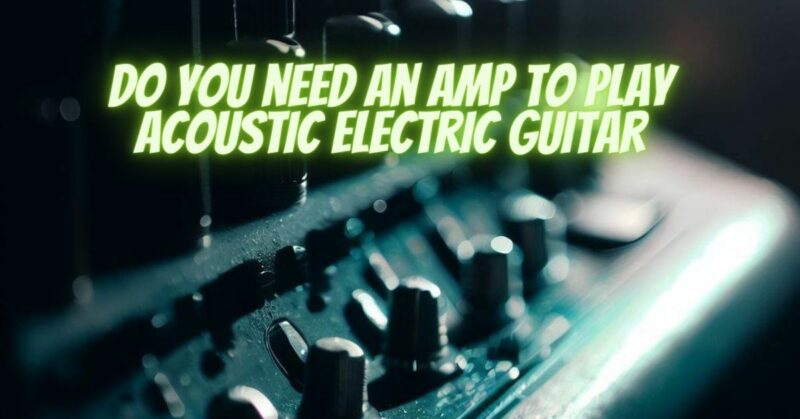The realm of acoustic-electric guitars adds a layer of versatility to the traditional acoustic guitar, blurring the lines between unplugged simplicity and the amplified grandeur of electric guitars. One common question that resonates among musicians is whether you need an amplifier for an acoustic-electric guitar. In this extensive exploration, we dissect the considerations, advantages, and potential sonic enhancements that come with using an amp for acoustic-electric guitars.
Understanding Acoustic-Electric Guitars:
1. Hybrid Nature:
Acoustic-electric guitars marry the acoustic resonance of traditional wooden bodies with the convenience of electronic pickups. This hybrid nature allows musicians to switch seamlessly between an unplugged acoustic sound and the amplified brilliance of an electric guitar.
2. Onboard Electronics:
The defining feature of acoustic-electric guitars is the presence of onboard electronics, including pickups and preamp systems. These components facilitate the translation of acoustic vibrations into electrical signals, paving the way for amplified performance.
Advantages of Using an Amp:
3. Projection and Volume:
While acoustic-electric guitars can be played unplugged, using an amp extends their projection and volume capabilities. This becomes especially advantageous in live performances, ensuring that the subtle nuances of fingerpicking or the intricacies of strumming can reach a larger audience.
4. Tonal Shaping:
Amplifiers provide a platform for tonal shaping, allowing musicians to tailor their sound according to the venue, musical genre, or personal preferences. The onboard preamp systems on acoustic-electric guitars often feature EQ controls, enabling adjustments to bass, midrange, and treble frequencies.
5. Effects Integration:
The use of an amplifier opens the door to a plethora of effects that can enhance the sonic palette of an acoustic-electric guitar. Reverb, delay, chorus, and other effects can be applied creatively to expand the sonic possibilities, adding depth and texture to the performance.
Considerations for Acoustic-Electric Guitar Amplification:
6. Acoustic Amp vs. Electric Guitar Amp:
Choosing the right amplifier is crucial. Acoustic amps are designed to faithfully reproduce the natural sound of acoustic instruments, providing a clean and transparent amplification. Electric guitar amps, while versatile, may color the acoustic sound and are often tailored for the distinct characteristics of electric guitars.
7. Size and Portability:
Consider the size and portability of the amp, especially if the intention is to perform in diverse settings. Compact and lightweight acoustic amps are designed for easy transport, making them suitable for gigging musicians who require mobility without compromising on sound quality.
Alternative Options:
8. PA Systems and Audio Interfaces:
In certain situations, musicians may opt for using a PA system or audio interface instead of a dedicated acoustic amp. This is common in larger venues or studio environments where a more extensive sound reinforcement system is in place.
9. Unplugged Performance:
It’s important to note that an amp is not mandatory for playing an acoustic-electric guitar. The inherent beauty of the instrument can be enjoyed in an unplugged setting, making it a versatile choice for intimate performances, songwriting sessions, or practice in quiet environments.
The decision of whether to use an amp for an acoustic-electric guitar hinges on the specific needs and preferences of the musician. While an amplifier offers expanded volume, tonal control, and effects possibilities, the intrinsic charm of an acoustic-electric guitar can shine even in unplugged scenarios. Striking the right balance between amplification and the natural resonance of the instrument is a dynamic choice that allows musicians to navigate seamlessly between intimate acoustic moments and the electrifying energy of amplified performances. In the ever-evolving landscape of musical expression, the acoustic-electric guitar, whether plugged in or unplugged, stands as a testament to the versatility and adaptability of this timeless instrument.


